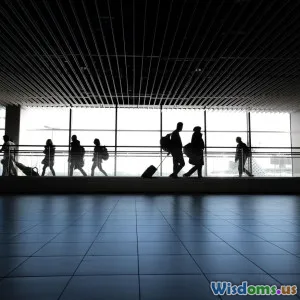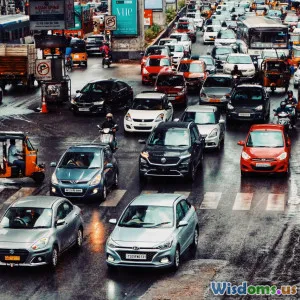
Will Upcoming Regulations Transform Air Cargo Transportation Safety
9 min read Exploring how new regulations are set to revolutionize safety standards in air cargo transportation worldwide. (0 Reviews)
Will Upcoming Regulations Transform Air Cargo Transportation Safety?
Air cargo plays a pivotal role in the global economy, enabling the swift delivery of goods ranging from critical pharmaceuticals to electronics and perishable produce. However, the rapid growth of this sector, juxtaposed with evolving security threats and operational complexities, has spotlighted safety concerns. As governments and international bodies prepare to implement new regulations, the question arises: will these forthcoming rules truly transform air cargo transportation safety?
This article explores the multifaceted impact of upcoming regulations, examining the current landscape, anticipated enforcement changes, technological integration, and forecasting how these shifts could redefine safety in air freight operations.
The Existing Landscape: Strengths and Vulnerabilities
Historical Context
Since the inception of commercial air cargo, aviation authorities such as the International Civil Aviation Organization (ICAO) and national regulatory agencies like the Federal Aviation Administration (FAA) have established comprehensive regulations to safeguard aircraft, crew, and cargo. These include protocols for hazardous materials handling, screening procedures, and aircraft maintenance standards.
Despite these measures, incidents such as the 2010 DHL crash in Baghdad due to mechanical failure and a series of mishandled dangerous goods leading to cargo fires have revealed vulnerabilities. Notably, in 2010, a UPS cargo Boeing 747 suffered a fatal accident due to a lithium battery fire, underscoring the importance of evolved safety regulations aligning with cargo content's changing nature.
Current Challenges
- Complexity of Cargo Types: The surge in e-commerce means more shipments, including higher volumes of dangerous goods like lithium-ion batteries, have entered the supply chain. Traditional regulations often lag behind such newer hazards.
- Security Concerns: Post-9/11 measures enhanced passenger screening, but cargo screening remains inconsistent globally. The diversity of carriers—from large integrators to smaller operators—complicates uniform safety enforcement.
- Technology Gaps: Legacy systems for tracking, inspection, and compliance do not always integrate effectively with modern digital tools, limiting the ability to monitor cargo conditions in real time.
Upcoming Regulations: Key Features and Objectives
Enhanced Dangerous Goods Controls
A primary focus of upcoming changes is stricter regulations on the carriage of hazardous and lithium battery goods aboard aircraft. ICAO's Technical Instructions and the IATA DGR updates scheduled for the next cycle address packaging, declaration, and screening more rigorously.
For example, starting in 2024, operators will face tighter restrictions on the state of charge for lithium batteries and increased penalties for misdeclaration. Airlines will be mandated to adopt advanced thermal runaway detection equipment within cargo compartments.
Mandatory Cargo Screening Increase
The European Union and the United States have both enacted progressive laws demanding 100% screening for all cargo loaded on passenger flights by end-2023. The goal is to prevent explosives and contraband from being trafficked, using methods such as x-ray computed tomography (CT) and explosive trace detection (ETD).
This regulation also compels all freight forwarders and ground handlers to implement stronger authentication protocols for consignments.
Digitalization and Data Transparency Push
Other notable incoming regulations incentivize adopting blockchain and Internet of Things (IoT) technologies for cargo tracking and documentation. The European Union Aviation Safety Agency (EASA) suggests interoperable platforms sharing real-time authenticity and safety data between parties, improving accountability and reducing errors.
Furthermore, data privacy regulations underline that cargo handling data must be protected while allowing necessary sharing among authorized stakeholders.
Transformative Effects: How Regulations Will Shape The Future
Improved Risk Mitigation
Stricter controls on hazardous materials and comprehensive cargo screening limit the possibility of dangerous incidents taking place. For example, air cargo operators like FedEx and DHL are investing millions annually into new fire suppression technologies aligned with regulatory mandates — a direct response to the imperative for reducing fire-related risks.
Heightened Industry Accountability
Regulations requiring rigorous documentation and transparency mean that every party in the cargo supply chain, from shippers to handlers, becomes more accountable. According to John Smith, Safety Director at IATA, "Enhanced data reporting and traceability will force the industry to root out unsafe practices that previously went unnoticed."
Technological Advancements Integration
The regulatory emphasis on digital tools is accelerating the adoption of sophisticated solutions responsible for improving cargo condition monitoring. Sensors embedded within cargo containers will relay temperature, humidity, and impact data instantly to central control rooms, reducing spoilage and incident risk.
Blockchain systems, promoted as a way to secure and authenticate shipment provenance, will streamline compliance audits and drastically cut paperwork errors.
Economic and Operational Impacts
While the upfront costs of regulatory compliance might challenge smaller operators, experts predict long-term savings through fewer accidents, lower insurance costs, and enhanced efficiency. The Airlines for America association estimates that streamlining paperwork and digital inspections alone could reduce turnaround times by up to 15%, prompting economic benefits across global trade routes.
Challenges to Successful Implementation
Despite promising benefits, challenges exist:
-
Global Harmonization: Discrepant regulations across countries might lead to increased complexity and compliance costs for international operators.
-
Technological Barriers: Smaller carriers may struggle to afford necessary updates, risking safety gaps.
-
Human Factors: Regulations rely heavily on consistent human adherence, which requires substantial training and cultural shifts.
Conclusion: A Safer, More Resilient Air Cargo Future?
The upcoming wave of air cargo transportation regulations signals a decisive move toward higher safety standards, risk transparency, and technological innovation. By strengthening hazardous material controls, enforcing comprehensive screening, and promoting digital transformation, these regulations promise to considerably enhance the safety landscape.
Industry stakeholders, regulators, and policymakers must cooperate to ensure smooth adoption, mitigate cost implications, and foster global regulatory alignment. With smart implementation, air cargo transportation can transform into a far more secure and reliable conduit for global commerce.
As John Smith aptly concluded, "The future of air cargo safety lies not only in rules but in how aggressively we embrace the tools and culture that uphold them."
The journey toward safer skies in air cargo is both an obligation and an opportunity — one that has the potential to save lives, protect assets, and advance global trade efficiency.
References
- International Civil Aviation Organization (ICAO) Technical Instructions. (2024).
- IATA Dangerous Goods Regulations Update. (2023).
- European Union Aviation Safety Agency (EASA) Reports. (2023).
- Airlines for America Economic Impact Studies. (2022).
- UPS Accident Investigation Board Report. (2010).
- FedEx Annual Safety Investment Report. (2023).
By examining both regulatory advances and their practical effects, this article aims to empower air cargo professionals and stakeholders with insights critical for navigating future safety landscapes.
Rate the Post
User Reviews
Other posts in Vehicle Safety & Regulations
Popular Posts















